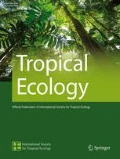Abstract
Anomalous coloration is defined as the excess or deficit of pigmentation in some region(s) or throughout the entire body of an animal, and have been classified as piebalism, leucism, or albinism. The first record of anomalous coloration for the collared peccary (Pecari tajacu) was a leucistic cub captured in dense ombrophilous Atlantic Forest in the municipality of São José dos Pinhais, state of Paraná, southern Brazil, which was subsequently raised by residents until it was an adult. Collared peccarys’s behaviors are well documented in literature, but there is no published scientific information about the behavior of leucistic individuals. Here we report the second case of anomalous coloration of the collared peccary (P. tajacu) in Brazil and the Neotropical region, and comment on its social interaction with pigmented conspecifics. For a period of 27 months of monitoring, cameras trap captured 109 records (47 videos and 62 photos) distributed among 21 days. We retrieved 22 independent events from the records, of which 54.5% were of the leucistic collared peccary alone and 45.5% with it interacting with pigmented conspecifics. During interactions it displayed both affiliative and agonistic behaviors. Collared peccaries live in stable herds of five to 25 individuals, with temporary sub-herds of one to three individuals that forage separately for several hours during the day. Considering that animals with an absence of body pigmentation are more susceptible to predation, the survival of the leucistic collared peccary may be associated with its social interaction with pigmented conspecifics.

References
Abreu MS, Machado R, Barbieri F, Freitas NS, Oliveira LR (2013) Anomalous color in Neotropical mammals: a review with new records for Didelphis sp. (Didelphidae, Didelphimorphia) and Arctocephalus australis (Otariidae, Carnivora). Braz J Biol 73:185–194
Acevedo J, Aguayo M (2008) Leucistic South American sea lion in Chile, with a review of anomalously color in otariids. Rev Biol Mar Oceanogr 23:413–417
Binkley SK (2001) Color on, color off. In: VanBrunt C (org) Teachers guide for the Young Naturalists. Minnesota Conservation Volunteer, Minnesota, pp 28–39
Biondo C, Izar P, Miyaki CY, Bussab VSR (2014) Social structure of collared peccaries (Pecari tajacu): Does relatedness matter? Behav Processes 109:70–78
Byers JA, Bekoff M (1981) Social, spacing, and cooperative behavior of the collared peccary, Tayassu tajacu. J Mammal 62:767–785
Campos JB (1999) A pecuária e a degradação social e ambiental do Noroeste do Paraná. Cad Biodiv 2:1–3
da Silva SSB, Le Pendu Y, Ohashi OM, Oba E, Albuquerque NI, Garcia AR, Mayor P, Guimarães DAA (2016) Sexual behavior of Pecari tajacu (Cetartiodactyla: Tayassuidae) during periovulatory and early gestation periods. Behav Process 131:68–73
de Kort D, Altrichter M, Cortez S, Camino M (2017) Collared peccary (Pecari tajacu) behavioral reactions toward a dead member of the herd. Ethology 124:131–134
Desbiez ALJ, Santos SA, Keuroghlian A, Bodmer RE (2009) Niche partitioning among white-lipped peccaries (Tayassu pecari), collared peccaries (Pecari tajacu), and feral pigs (Sus scrofa). J Mammal 90:119–128
Fertl D, Rosel P (2002) Albinism. In: Perrin WF, Würsig B, Thewissen JGM (eds) Encyclopedia of marine mammals. Academic Press, San Diego, pp 24–26
Galetti M, Pedrosa F, Keuroghlian A, Sazima I (2016) Liquid lunch–vampire bats feed on invasive feral pigs and other ungulates. Front Ecol Environ 14:505–506
Garipis N, Hoffmann KP (2003) Visual defects in albino ferrets (Mustela putorius furo). Vis Res 43:793–800
Grant S, Patel NN, Philp AR, Grey CNB, Lucas RD, Foster RG, Bowmaker JK, Jeffery G (2001) Rod photopigment deficits in albino are specific to mammals and arise during retinal development. Vis Neurosci 18:245–251
Keuroghlian A, Eaton DP, Longland WS (2004) Area use by white-lipped and collared peccaries (Tayassu pecari and Tayassu tajacu) in a tropical forest fragment. Biol Conserv 120:411–425
Kiltie RA, Terborgh J (1983) Observations on the behavior of rain forest peccaries in Perú: why do white-lipped peccaries form herds? Z Tierpsychol 62:241–255
Miller JD (2005) All about albinism. Mo Conserv 66:4–7
Parsons GJ, Bonderup-Nielsen S (1995) Partial albinism in an island population of Meadow Voles, Microtus pennsylvanicus, from Nova Scotia. Can Field Nat 109:263–264
Sazima I, Di-Bernardo M (1991) Albinismo em serpentes neotropicais. Mem Inst Butantan 53:167–173
Summers CG (2009) Albinism: classification, clinical characteristics, and recent findings. Optom Vis Sci 86:659–662
Veiga LA (1994) Um caso de albinismo em Tayassu tajacu Linnaeus (Artiodactyla, Tayassuidae) na Serra do Mar, São José dos Pinhais, Paraná. Rev Bras Zool 11:341–343
Acknowledgements
We are grateful to two anonymous reviewers for valuable comments on the manuscript. F. H. Oda receive postdoctoral fellowship from Fundação Cearense de Apoio ao Desenvolvimento Científico e Tecnológico – Funcap/Coordenação de Aperfeiçoamento Pessoal de Nível Superior – CAPES (Grant Number 88887.162751/2018-00).
Author information
Authors and Affiliations
Corresponding author
Rights and permissions
About this article
Cite this article
da Silva, V.L., Cândido, J., Campanha, J.N. et al. A stranger in the family? On the social behavior of a leucistic collared peccary (Pecari tajacu) with pigmented conspecifics. Trop Ecol 60, 303–305 (2019). https://doi.org/10.1007/s42965-019-00036-x
Received:
Revised:
Accepted:
Published:
Issue Date:
DOI: https://doi.org/10.1007/s42965-019-00036-x

